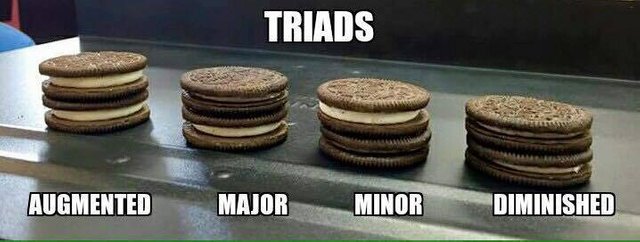Music theory made easy - with cookies! Chords explained in 5 mins
I saw this image online, and it while does a great job of explaining triads to anyone who already knows what it means, but if you don't, well, what does it mean? Well, here's a brief explanation I came up with. It should make sense, but if anything's unclear please let me know in the comments

(and to be clear, this is not my image - author unknown, or I'd credit them. All text here is, however, mine)
A triad chord consists of three notes, but you can also think of that as a start note ('root'), and then two other notes some distance away. You start on one note, move to another, then move to a third. Those movements are called intervals, and when dealing with triads, will be either 3 or 4 semitones (notes). This gives us two options for each:
0, or m, or 3 semitones, or a minor third interval, or an empty oreo (these are all the same thing)
1, or M, or 4 semitones, or a major third interval, or a full oreo (these are all the same thing)
Given that our possible combinations for two digits are:
00
01
10
11
To put that in m/M notation, that is:
mm = diminished triad
mM = minor triad
Mm = major triad
MM = augmented triad
Now, we only have two digits here, so how are these triads? That's because we're dealing with intervals, and an interval goes from somewhere to somewhere, so the third part, the root, is already implied.
If that's a bit too abstract, here's an example. Remember:
m = 3 semitones (aka up 3 notes)
M = 4 semitones (aka up 4 notes)
Pick a root, any root. Let's say... F
Now pick a chord type - let's say major, which is Mm so our formula is going to be
F, M, m
which is
F, 4 semitones up, 3 semitones further up
which gives us:
F, A C, which is in fact F major
F minor would be:
F, m, M
so:
F, 3 semitones up, 4 semitones further up
giving:
F, G#, C, which is F minor
Try this for any chord. There you go, boom. music theory.
This also explains why when you're playing on only white keys (C major/ A minor) the triad starting on B is the odd one out in terms of sound. It's diminished, when all the others are major or minor.
So there you have it. Music theory with cookies. Happy musicmaking!
(Edited for minor typos)
As far as I understood, augmented must be my favorite one :P
Being a self taught musician, I know almost nothing about music theory, but I will try to learn from this post.
Thank you for sharing, keep on playing!
Thanks! Glad to know someone enjoyed it at least, I'm always afraid my posts are just gonna be ignored.. so long as at least one person gets something from it, it's worthwhile to me :)
I'm something of a music theory nerd, so if there's interest in it I may do some more of these kind of bite sized tutorials
I tried to read it with more attention and yes, it's totally easy to create triads with your method!
Music theory for me always was something difficult, boring and somehow useless, but with your advice is much easier!
About posts being ignored, I know the feeling very well, but I'm accustomed to it too :)
Your method captures the two variable intervals, being either 3 or 4 semitones, between the three digits/fingers of the triad/chord. That is, you capture the essence of a basic chord.
The four triads can also be shown using whole numbers, representing the starting note 0, and the number of semitones to be jumped.
0 3 3 = mm = diminished triad
0 3 4 = mM = minor triad
0 4 3 = Mm = major triad
0 4 4 = MM = augmented triad
Both methods apply to any of the twelve notes of the octave.
As you mention, noodhoog, you can add a fourth digit to the triad, with a variable third interval, to create four digit chords.
0 4 3 3 = Mmm = M7 = Major 7th
This method allows for more digits, and intervals other than m = 3 or M = 4. All chords can be described this way.
Ex. C E G C = 0 4 3 5 = C Major = any 'complete' major chord, repeating the root.
The twelve-semitone interval method can describe the whole of music theory, which is currently organized around the seven notes of the major scale.
I would like to present the octave as the unit of organization for music theory on Steemit. In short posts of my own.
Learning music while fattening up, right? Just kidding. Anyway, so the chords are made of 3 notes: a root note and 3 or 4 intervals apart notes, right? By the way, I would love some more tips on music theory.